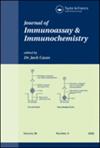Caveolin-1对子宫内膜样内膜癌的双重影响:组织病理学和免疫组化研究。
Q2 Health Professions
引用次数: 0
摘要
本研究旨在评估子宫内膜样内膜癌中洞穴素-1的表达及其与临床病理参数的相关性。44例子宫内膜样内膜癌患者接受了根治性子宫切除术。用免疫组化方法对存档的石蜡切片进行洞穴素-1染色,18.2%的病例在癌上皮细胞中检测到洞穴素-1的表达,65.9%的病例在基质中检测到洞穴素-1的表达。上皮细胞中 Caveolin-1 的表达与 T 分期和 FIGO 分期呈显著正相关。上皮细胞中 Caveolin-1 的阳性表达与其他器官的侵犯有直接、积极和显著的关系,与 FIGO 晚期也有直接和显著的关系。至于基质中 caveolin-1 的表达,它与子宫肌层的侵袭呈显著负相关。此外,上皮中 caveolin-1 的表达与基质中的表达也呈显著负相关。我们的结论是,Caveolin-1 的表达在子宫内膜样内膜癌中作为肿瘤抑制因子或侵袭促进因子发挥着重要作用。在早期病变中,较高的基质水平似乎对病变的进展具有保护作用。而基质表达减少和上皮表达增加与侵袭性肿瘤有关。本文章由计算机程序翻译,如有差异,请以英文原文为准。
Caveolin-1's dual impact on endometrioid endometrial carcinoma: a histopathological and immunohistochemical study.
The objectives of this study are to evaluate caveolin-1 expression in endometrioid endometrial cancer and its correlation with clinicopathological parameters. Forty-four cases of endometrioid endometrial carcinomas underwent radical hysterectomy. The archived paraffin sections that were stained for caveolin-1 by immunohistochemistry, caveolin-1 expression were detected in cancerous epithelial cells in 18.2% of the cases, and stromal caveolin-1 was detected in 65.9% of the cases. Caveolin-1 expression in the epithelium showed a significant positive association with the T stage and the FIGO stage. Positive caveolin-1 expression in epithelium has a direct, positive and significant relationship with invasion of other organs and a direct and significant relationship with the advanced FIGO stage. As for caveolin-1 expression in the stroma, it showed a significant negative inversely significant association with myometrial invasion. Also, there is a significant negative association between caveolin-1 expression in the epithelium and its expression in the stroma. We conclude that caveolin-1 expression strongly plays a critical role in endometrioid endometrial carcinoma as a tumor suppressor or promoter of invasion. In early lesions, high stromal levels appear to be protective against progression. While decreased stromal expression and increased epithelial expression were associated with aggressive tumors.
求助全文
通过发布文献求助,成功后即可免费获取论文全文。
去求助
来源期刊
CiteScore
3.50
自引率
0.00%
发文量
38
审稿时长
>12 weeks
期刊介绍:
The Journal of Immunoassay & Immunochemistry is an international forum for rapid dissemination of research results and methodologies dealing with all aspects of immunoassay and immunochemistry, as well as selected aspects of immunology. They include receptor assay, enzyme-linked immunosorbent assay (ELISA) in all of its embodiments, ligand-based assays, biological markers of ligand-receptor interaction, in vivo and in vitro diagnostic reagents and techniques, diagnosis of AIDS, point-of-care testing, clinical immunology, antibody isolation and purification, and others.

 求助内容:
求助内容: 应助结果提醒方式:
应助结果提醒方式:


